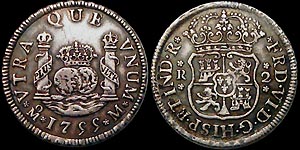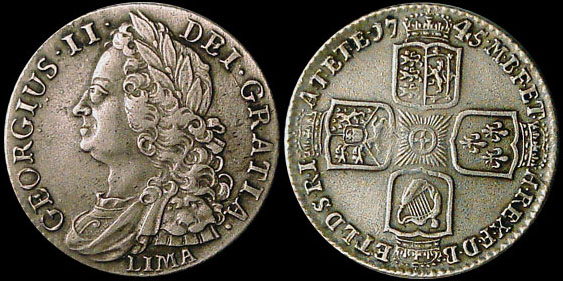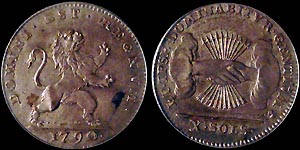|
More Than a
Metal
Disk...
Three
Examples
By Rick
Engstrom, WINS#483
Sometimes it’s enough
that a coin is pleasing to the eye, or a rare find – seldom seen by
non-collectors. There’s something to be said when you look at a gem
example of a coin that has survived history with hardly a mark to note
the time that passed. Many coins in my collection are there for no
other reason than aesthetic.
Sometimes, there’s
more. Most collectors of early coinage could go into great detail on
the symbolism depicted within the designs. Subtle meanings represented
in the devices can carry significant importance. Tragically, I think
this greatly lacks in modern coinage, as it’s what makes a coin more
than just a metal disk. Sometimes these subtle designs carry
considerable historical value. The following are a few examples from my
collection.
#1. The Pillar
Coinage of the Spanish South American Colonies:

1755 M, Mo 2 Reales, KM# 86.1
Pictured above is a nice, mid-year example of Two Reales. At
first glance, the coin has a pleasing tone. A closer examination would
reveal evidence of die clash, likely causing the break along the
reverse. It’s not a rare coin, by any means, but it is a scarce grade.
Mid-grade examples can be found by collectors for well under $200.
Buyers should beware: this type coinage is highly subject to
counterfeits, and beginners should purchase exclusively through notable
and trusted sources.
What else? Take
note of the reverse design; the two globes that depict the old and new
world combined beneath the Spanish crown, with the legend “UTRA QUE
UNUM” (One World) flanked by a representation of the Pillars of
Hercules boasting the script “Plus Ultra” (And More Beyond). Now, this coin has become a
representation of the discovery of the new world, and the establishment
of Spanish colonies in Central and South America, so rich in silver
that the pillar coinage became the workhorse of 18th century specie
coinage trade (and, much later, the primary focus of my collection).
Examples of this coinage can be found today chop-marked, cut sectional,
counter-stamped and punched through, as evidence of its global travel
and worldly commercial acceptance.
#2. English
“LIMA” coinage of 1745-46:

1745 "LIMA" Shilling, KM# 583.2
Next, I present the 1745 English shilling. This is another nice example
of a fairly common coin. There is notable weakness in the center
reverse, and in all fairness, the surface is a slightly porous.
Overall, it’s a nice piece, but better can readily be found. A coin
like this would likely set a collector back about $100, give or take.
What separates this coin from other 18th century shillings, most
notably, is the word “LIMA” found within the legend, below the bust of
King George II. That’s an important little addition. Its explanation
begins with Admiral Anson and his voyage around the world. With England
at war with Spain, his mission was to sail around the world and harass
the American colonies, likely in effort to disrupt the flow of silver
to the Spanish crown. The mission became a tragic tale of disaster,
setbacks, and failure. That all changed, however, when his ship, the Centurion, on her way home from
Jakarta in 1743, managed to intercept the Spanish Galleon Neustra Senora de Covadonga, and
seize her silver abundant cargo, in route from Acapulco. He returned
back to England with his Spanish silver, where it was used to mint
standard coinage which boasted one notable addition from previous issue
– the word “LIMA” below the bust, to note the origin of the silver used
to mint the coin.
#3. Insurrection Coinage of the Austrian
Netherlands:

1790 Austrian-Netherlands 10 Sols (10 Stuiver), KM# 47
Talk about rare.
Insurrection coinage of the Austrian Netherlands was issued in one
single year – 1790 (ideal to those type collectors out there who enjoy
a challenge). Beyond that, the mintage of this particular coin was a
scarce hair over a mere 8,000 pieces. It’s got fantastic patina, and a
beautiful design, and a couple of unfortunate blemishes that are a bit
more pronounced in the digital image. I’ll admit that I do find it hard
to look at the rampant lion and not be reminded of the Wizard of Oz
(“Put up your dukes!”). If you’re lucky to find this coin in a similar
grade, be prepared for a bit of a sticker shock unless your hobby funds
greatly outweigh my own, but with a little patience mid-grade examples
can be had in a more comfortable price range.
The value of this coin does not stop there. The insurrection resulted
when Emperor Joseph II abolished the constitutions of Hainault and
Brabant. It was in Brussels, 1790, that the seven provinces in revolt
against the emperor signed a treaty (a likely depiction illustrated on
the reverse of this coin, also minted in Brussels, 1790), and
established the confederation, “United Belgian States”. The union
quickly turned turbulent and subject to opposing internal factions,
however. Joseph II died that same year, and was succeeded by his
brother, Leopold, who restored the constitutions and returned the
provinces under Austria in 1791, thus explaining the short lived series
of this beautiful coinage.
I was prompted to write this after attending a fantastic show this
weekend. I found myself in the midst of a crowd of fellow collectors,
and I was struck to see how many were looking for “this coin” in “that
grade”. In fact, that has been my objective on more occasions than not,
so I could certainly appreciate the thrill of that hunt. But as I
looked at all the displayed inventories, I couldn’t help but ask
myself, “What else is on this table and how much isn’t seen?”
In the future, I hope to tell you more about a Swiss Shooting Taler I
picked up at that show, but the truth is I purchased it just because it
was fantastically pleasing to the senses.
Copyright © 2008
by Rick Engstrom.
|

